“Routes: 20th Century Japan in Objects, Images, and Personal Exchange”
“Routes: 20th Century Japan in Objects, Images, and Personal Exchange”
Joanne Bernardi
Guest Lecture, Dept. of Languages, Literatures and Linguistics
Syracuse University, 1 April 2016
NOT FOR CITATION WITHOUT PERMISSION OF AUTHOR

[SLIDE #1]
Thank you for inviting me here today, and for this opportunity to tell you about my ongoing, collaborative digital humanities project, Re-envisioning Japan: Japan as Destination in 20th Century visual and material culture [hereafter referred to as REJ], which conjoins both a physical collection and digital archive of tourism, travel, and educational ephemera documenting changing representations of Japan and its place in the world in the early to mid 20th century. Right now REJ is at a critical turning point, with two new developments underway. First, I recently donated the physical collection of ephemera that I’ve amassed over the past 15 years to sustain this project to the University of Rochester’s Department of Rare Books, Special Collections, and Preservation. This will facilitate enhanced metadata, make the collection more accessible, and guarantee its preservation. It also frees up our dining room, which has been a makeshift film archive for the past 6-7 years, so my family is happy, although they are resigned to my apparent inability to stop adding to the collection. Second, my project team members and I are making steady progress in designing a much more user-friendly and extensible Omeka-based site that will replace the current WordPress based site that I am introducing today. This migration will ultimately allow me to take the project in new and exciting directions, and that is my focus today.
My presentation today is in two parts:

[SLIDE #2]
I begin with some background and a description of the project that addresses some of the challenges and rewards of negotiating between digital and physical worlds. Next, I outline plans for further developing REJ over the next year and a half. I look forward to any feedback you might have as this project is a constant work-in-progress.
I. INTRODUCING RE-ENVISIONING JAPAN

[SLIDE #3]
Digital environments enable us to see things differently, and the title “Re-Envisioning Japan” capitalizes on this virtue. Online collections of material culture invite us to interrogate enduring and dominant historical narratives that have become abstracted over time (as Peter Miller notes), detached from the antiquarians understanding of the past through the world of things. History is not exclusively embedded in words; objects also resonate with historical voice. REJ gives us access to the world of tangible things marked by traces of the human touch. It opens up new possibilities to comprehend life in 20th century Japan on a granular level through narratives of personal use and personal encounters embodied by everyday objects. At the same time, because of the flexibility of the digital environment, we can look for larger patterns and relationships that add nuance to studying patterns of difference among diverse cultures and societies, and the encounters between them.
During the course of collecting, researching, and interpreting the objects in the REJ collection and their reiterative paths of circulation and exchange, I became preoccupied with the relationship between objects and history: how material loss affects the history making process, the role of objects in forging global connections, and the role of the particular objects in my collection as tangible evidence of Japan’s social, cultural, economic, and political transformations during the first decades of the 20th century. After about 10 years, the collection had reached sizable proportions as a resource for my research and teaching, and I began collaborating with colleagues in the River Campus Libraries Multimedia Center (which is now the Digital Humanities Center) in order to digitize the wide range of diverse media. We completed the current digital environment for the collection’s online presentation in December 2013. A little over two years later, most of the collection of over 3,500 objects is accessible online, and the process of digitizing and adding objects to the site is ongoing. At first I thought technological mediation was just a means to an end, a way of providing others with access to this scholarly resource and pedagogical tool. Instead, digital mediation became the catalyst unleashing the collection’s potential to make meaning. The creative curation of material objects in digital space intensifies their historical voice, allowing the meaning they embody to resonate in ways that are not easily contained by the written word alone.
As I describe in brief background notes on the website, my physical collection began as a search for photographic images of early 20th century Japan that might bring me closer to the landscape and life of a period that had long been the focus of my previous research on Japanese silent cinema. I was looking in particular for photographic representations of Japan that could complement my growing familiarity with early and silent films from Europe, the United States, and (to a much lesser extent), other parts of the world, providing me with a better understanding of Japan’s place in that world. I was not thinking of photographic images in books–“disembodied” photographs as illustrations–but rather photographs as objects, “time-bound physical artifacts,” like moving images themselves.
The Internet’s unprecedented capacity to facilitate access to a wide range of material culture on a massive scale has been key to the development of this project. The first objects I purchased were postcards from the 1900s-1930s that are readily available on online auctions; I was initially drawn to postcards as visual records of place, especially the urban landscapes more likely to have been captured on film:

[SLIDE #4]
I soon came to appreciate the many other ways that postcards connect us to the past: as traces of relationships, such as picture postcard exchanges between pen pals or missives that were often deeply personal;

[SLIDE #5]
as visual records of Japan’s presence at European and American world’s fairs and expositions;

[SLIDE #6]
and as glimpses of Japan’s rising profile in the international world order (“Our Allies” and “Flags of All Nations”).

[SLIDE #7]
I even discovered postcards with images of a surprising number of imaginary Japans, such as the Japanese Village in Massachusetts (Wonderland Amusement Park at Revere Beach), described in a caption as a “15 minute tour of the Flowery Kingdom complete with its own Mt. Geisha:

[SLIDE #8]
Writing about the complicated origins of the early travel film genre, Tom Gunning describes turn-of-the-century and early 20th century travel and its relationship to travel imagery as “a means of appropriating the world through images,” noting the role postcards had as part of this phenomenon. The nature of postcards as embodiments of image and movement (travel by people, and the circulation of things) as well as evidence of place helped determine REJ’s focus on objects belonging to broadly defined categories. I shaped the contours of the collection’s conceptual, chronological, and generic parameters with less interest in superlative collecting than in exploring the range and variety of ephemeral objects encountered, salvaged and offered for sale from the “infinite archive of the past.”
Travel- and education-related objects form the bulk of the REJ collection and fall into working categories that complement each other in useful ways. “Tourist Japan” was an early title for the project, linking the virtual armchair traveler reading about Japan with tourists moving through physical space. Although the words “tourist” and “tourism” can denote passive consumers and mindless consumption, they can also be flexible and inclusive. The rise of 20th century tourism is central to understanding 20th century cultural flow and identity; the tourist perspective is personal, allowing for a multiplicity of narrative perspectives. I was increasingly attracted to a wide range of ephemera as material evidence of personal experience. The historical contexts of their design and use were significant and informative, but they were especially compelling as used objects:

[SLIDE #9]
Victoria Kelley describes objects looked at from this perspective as “bearers of trace, scarred with the markers of time and use.” When postcards issued by Japanese and U.S. shipping companies led to the discovery of travel brochures and other tourism ephemera, these things evoked a connection with the past that was stunningly direct.
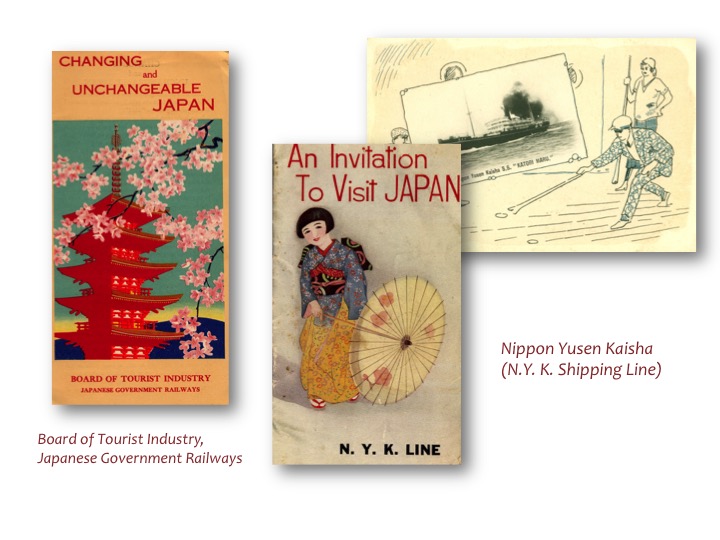
[SLIDE #10]
Such artifacts are not just evidence of modes of transportation, travel and leisure at a specific historical moment: in addition to their evidenciary value, informing us of the cultural, political, and economic systems that produced them, they are immediate links to the people who used them.
REJ is divided into 5 generically distinct “exhibits.” “Edification and Information” comprises works on general culture, history, and language; missionary and social work-related materials; objects dating from the Allied occupation of Japan (1945-1952); and U.S. World War II propaganda related to Japan.

[SLIDE #11]
“Leisure and Entertainment” includes objects (including some postcards) related to advertising, shopping, and Japan’s presence at international expositions, exhibitions, and worlds fairs. Photographs, slides, and stereographs are joined by several genres of literature, including children’s literature, magazines; memoirs and travel literature. Japanesque or Japan-inspired sheet music is also included here because it represents an early instance of Japanese influence on twentieth-century American popular culture.

[SLIDE #12]
“Moving Images” defined the twentieth century in an unprecedented way. They are represented on the site by small gauge films (16mm, Regular 8mm, and Super 8mm), ranging from the anonymous amateur travel film to widely circulated educational titles.

[SLIDE #13]
“Postcards” are divided into seventeen subgenres, ranging from actors, children, cities and sites, and “colonial” to occupation, recreation, war, and women. These categories are only examples of the rich diversity that characterizes this mode of communication.

[SLIDE #14]
The final exhibit is “Tourism and Travel.”

[SLIDE #15]
The human act of travel generates a wide variety of objects, including brochures, guides, hotel ephemera, maps, and ephemera related to transportation by air, land and sea. This also includes postcards, most notably those of major shipping lines like Nippon Yusen Kaisha (the NYK Line). Travel Guides are divided into “general” (general guides to Japan the country) and “specific” (guides to specific locations).
When we created the basic architecture for the REJ, we reiteratively designed a layout that mirrors my decisions in collating, classifying, and cataloging the physical collection. This was also based on the taxonomy that I devised for the objects; in this digital space, taxonomy functions as a powerful rhetorical tool. Displaying the wide range of formats in ways that would best represent physical objects in a two-dimensional environment was challenging: we use a page turning app, for example, for sheet music and postcard fronts and backs are scanned separately and then stitched together. Moving images are a unique feature (we have recuperated, repaired, and digitized 180 titles so far.

[SLIDE #16]
These films represent critical intersections between small gauge film, tourism, and education through the 1970s. Objects that are presented with a page turning app and 46 songs in the sheet music collection that were specially recorded for the project feature a red “Read More” button in the lower right hand corner that allows users to explore select inside content, or listen to a song:
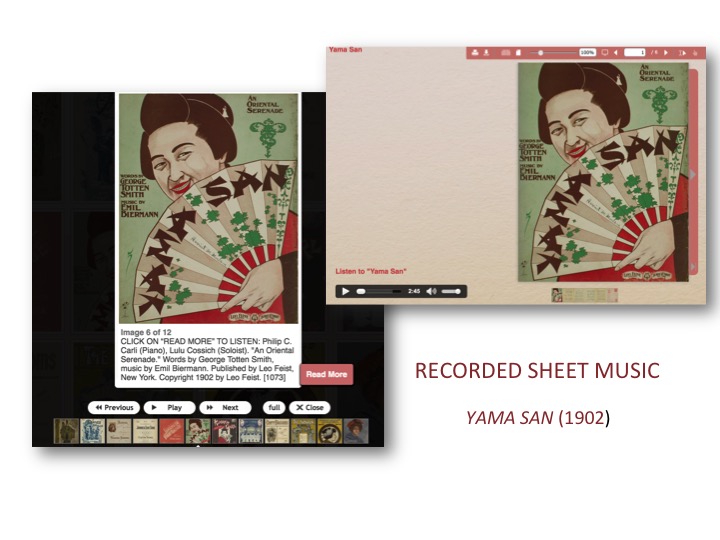
[SLIDE #17]
I have a 1.5 minute clip of REJ in action that I’d like to share with you to illustrate these functions, as well as the site’s general layout [Quicktime clip not available here]:

[SLIDE #18]
II. FUTURE DIRECTIONS
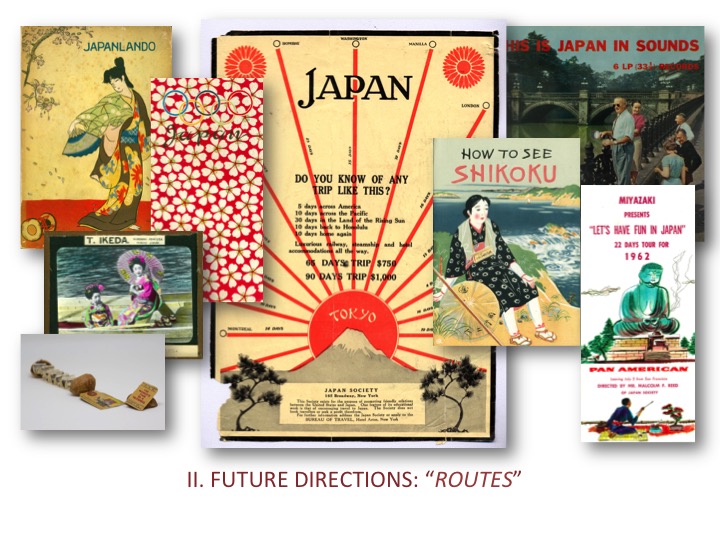
[SLIDE #19]
REJ is now entering into the third stage of development as a digital archive, a phase that could be characterized as re-envisioning REJ. Our objective is to maximize REJ’s scholarly impact by extending it with enriched metadata, “contextual mass (aggregated digital scholarship contextualizing the collection), and an open-access, web-based publishing platform, called ROUTES, that will push the boundaries of traditional web publishing and promote multimodal digital scholarship across disciplines. The working title for this publishing platform (which will focus on object-based scholarship and pedagogy) is “Routes,” inspired by James Clifford’s 1997 eponymous book about the complexities of cultural mobility and cultural encounters in the modern world. In this context, “Routes” is meant to suggest the circulation of objects, of trade, and of pathways through collections and websites. These two tasks will entail our moving further beyond merely creating a digital presence for ephemeral objects to redefining the digital archive as critical scholarship.
For the past two years, devising best practices for digitizing the diverse formats of material in the collection (e.g., brochures, postcards, sheet music, guide books, glass lantern slides, photographs, and 16mm, 8mm, and Super 8mm films) and website design has precluded the sustained research that is essential to maximizing the scholarly relevance and impact of this project. I am now focusing on augmenting REJ with detailed metadata and other contextualizing content for the new REJ digital archive (e.g., filmed or photographed encounters with specific objects or object groups, photo essays, and curatorial notes). Metadata for the objects in the collection exists, but the current WordPress platform for the REJ digital archive has been cumbersome to work with. As a result, its integration with corresponding objects on the current REJ site is limited (hence the migration to Omeka that is already underway) [examples of REJ object metadata in current site and Omeka]:
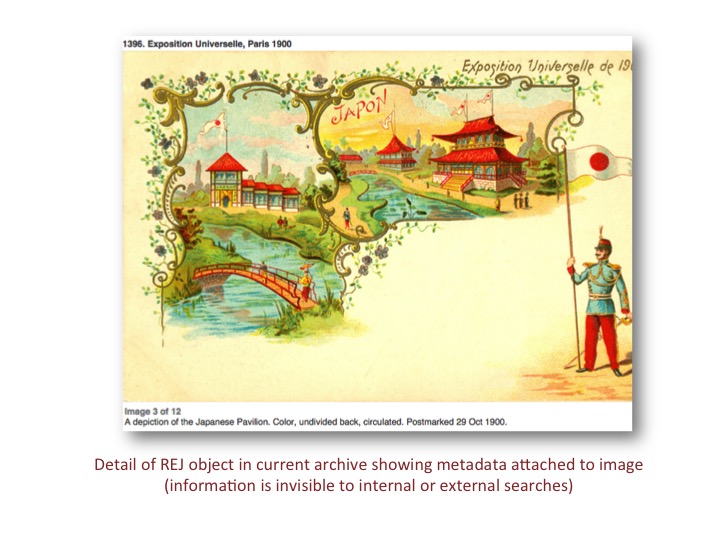

[SLIDES 20-21]
Creating more robust metadata that provides a more nuanced context for the objects in the collection is especially critical because it will allow REJ to contribute to and participate in the larger global research ecosystem that is rapidly being defined by projects like the Digital Public Library of America (DPLA) and the Advanced Research Consortium’s catalogue. This will increase the project’s relevance across a wide range of disciplines and promote broad-based scholarly engagement with digital humanities. Recuperating Japan’s engagement with the increasingly global leisure, communication, trade, and commercial networks in the first half of the 20th century will also help redress the lack of diversity across the web, where English language resources overshadow the smaller number of resources from the non-Western world. Diversifying the “white space” of the web is a major objective of our plan to extend REJ.

[SLIDE #22]
Digital platforms like Re-Envisioning Japan promote multimodal scholarship that accommodates the dynamic variety of human experience in singular ways. REJ already capitalizes on and models many of the benefits that humanistic digital scholarship affords, but future plans for the project will result in an enhanced REJ site that allows for growth and improvement. Building an original collection of primary sources (ephemeral objects often overlooked by collecting institutions) has contributed to REJ’s lengthy trajectory, but this project also compelled me to search out new disciplinary approaches (material culture studies, tourism studies, and film preservation), new working relationships with colleagues in libraries and archives, and a new mode of scholarly communication. Digital scholarship is inherently interdisciplinary and collaborative, and it is often in the margins between disciplines that we find those questions that are most relevant today. As a multimodal digital journal dedicated to object-based research and teaching, “Routes” will help forge connections across disciplines, promoting and sustaining interest in the advantages of digital scholarship and its particular propensity for recuperative research using online collections. An improved and augmented REJ site will exemplify the value of unique, ephemeral, and too-often neglected primary resources for scholarly research and teaching. REJ’s intellectual organization, the comparative context it provides, and its variety of resources make it potentially useful for innovative, object-based research by scholars in many fields.
In addition to facilitating conceptual shifting among disciplinary perspectives, digital archives like REJ encourage experimentation with context, organization, and description, allowing us to re-imagine contexts of the past by connecting things in relevant and meaningful ways. This approach is uniquely suited to the exploratory and interpretive methods of inquiry intrinsic to the study of material culture. Objects in the REJ collection signify on different levels (negotiating synchronic and diachronic contexts is key to understanding their relevance), and expanding into digital space allows users to experiment with different contexts for understanding REJ objects in ways that best accommodate the often dense, non-verbal expressivity of many of these objects. The term “recombinatory” is used to refer to the digital domain’s capacity for aggregating and contextualizing in close proximity objects, information, data, and scholarship from a wide range of sources, facilitating connections between nodes of scholarly activity (over time or at discrete points in time) that would otherwise remain scattered and fragmented. The richer we make REJ’s metadata and contextual scholarship, the more “linkable” it will become, promoting new scholarly discoveries, collaborations, and interdisciplinary partnerships.
I have already started to storyboard a prototype object encounter with this object, “The World’s Fair in a Nutshell” as my first subject:
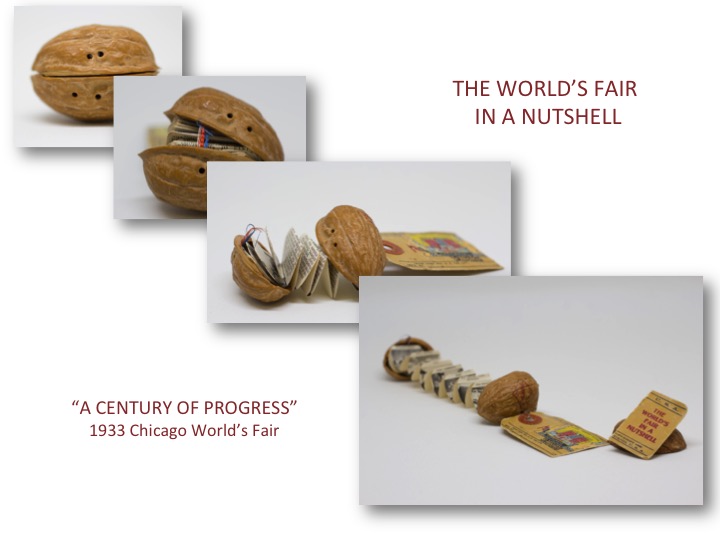
[SLIDE #23]
This is a promotional souvenir commemorating the 1933 Century of Progress World’s Fair in Chicago. Japan was among the nations represented at the fair, which was held to celebrate the city’s centennial in 1933-34. This tiny item reveals the power of objects to convey information: knowledge that can complement other sources, provoke us to ask new questions, or explore new social relationships and themes. Moreover, “The World’s Fair in a Nutshell” is useful as a case study of the dynamic relationships shared by many objects in the collection. The collection contains many items related to exhibitions and world’s fairs, including commemorative postcards and objects that inform us about customs (promoting Japanese tea, for example) that prevailed at Japan’s pavilions for such events. Finally, as a small object that embodies a large amount of information, it acts as a synecdoche for the Re-Envisioning Japan Project as exploratory, scholarly research that seeks to unfold the many facets of the past as it relates to Japan through the things people used to fashion identities and shape social relations. I chose this object precisely because at a glance it yields no obvious connection to Japan, although we know that Japan was represented at the Fair, which was a significant occasion for nation branding. The nutshell’s informative capacity in this respect becomes clear only after more thoughtful interpretation. This is a good example of the maxim in material culture studies that the levels of meaning we can derive from an object depend on the questions that we ask. Re-Envisioning Japan provides us with opportunities to rethink large historical process through the careful consideration of seemingly trivial objects.
This encounter will be in three parts. The first part will focus on a description of the material qualities of the object, followed by a second part on the deductions we make in response to the questions that arise after haptic exploration (e.g., Was this made to publicize the event before or after it opened? What informed the choices of buildings that are represented in the accordion-style fold out that the nutshell contains? When was it made? Who is it for?). The third part explores subsequent avenues of interpretation that connect the nutshell with a constellation of other objects in the collection, in particular a postcard depicting the young women in kimono who served tea at the Japan Pavilion. This object leads us to a filmed interview with one of these women featured on Denshō, an oral history project and digital archive dedicated to the experience of Japanese Americans who were incarcerated during World War II:
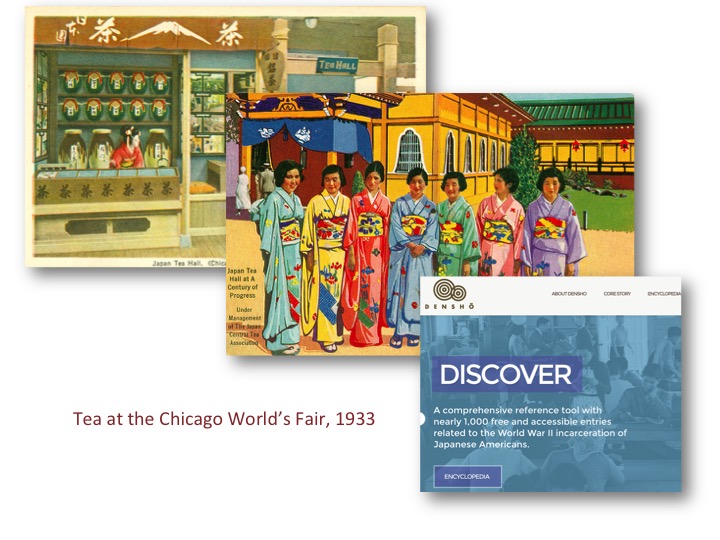
[SLIDE #24]
This prototype encounter demonstrates how REJ can be used as a tool: by focusing on the material remains of the past, their inherent or ascribed meanings and associations in different contexts and from different disciplinary perspectives, we can uncover and explore past lives and individual interactions. Through the objects in the REJ collection, we can also interrogate the past to test assumptions about the present. Because of REJ’s intentional focus on points of connection between Japan and the United States, some REJ objects, like this nutshell souvenir, lead us to the Japanese-American experience and, by extension, patterns of racial discrimination that persist to this day.
I lead similar exercises in “Tourist Japan,” a course that I have been teaching since 2002 as a venue for working through my ideas. I am now on the seventh iteration of the course (the syllabus is available on REJ under “About” on the main menu). In “Tourist Japan,” I use travel and tourism culture to illuminate the relationship between Japan’s modernization processes and identity formation. Students work with the objects in the REJ collection as an alternative approach to understanding 20th century Japan and patterns of human interaction and cross-cultural exchange. There is a productive, reciprocal relationship between my digital scholarship and my teaching, and “Tourist Japan” has evolved over the years as I have become increasingly preoccupied with thinking critically about the intersection of digital humanities practice and material culture studies. I currently teach the course as a digital humanities lab, with hands-on sessions during class devoted to interpreting, interacting with, and visualizing objects in the REJ collection. Students learn to develop metadata (the logistics as well as the philosophical questions that inevitably arise in describing an object) and digital curation. The course has a companion Omeka-based website that students use to create their own exhibits using REJ objects [excerpt of exhibit by “Tourist Japan” student Patrick Sullivan, April 2014]:
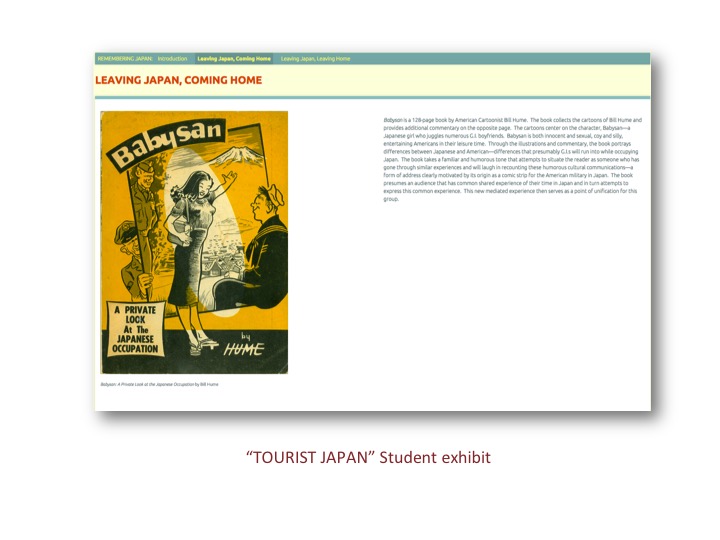
[SLIDE #25]
Both the physical objects and the digital archive are important tools that complement secondary reading assignments and films. This hybrid pedagogical model opens up opportunities for new direction in the critical analysis of these objects and the world they reflect..
In contrast to the physical REJ collection, the REJ digital archive is still young. Its productive life as useful scholarship has only just begun. At this transitional moment, my colleagues and I are carefully considering the digital archive’s ostensible future, its shelf life, where it might be in 20 or 30 years.
User interaction and collaboration have been an important objective for us throughout the project. We are thinking of how to make the digital archive increasingly interactive, encouraging collaborative scholarship through contributions by registered users. We are also thinking of new ways to dynamically present fragile objects and less common media (e.g., film strips, view master slides), and new tools to enhance research capability. We are considering a spatial tool for researchers to create historic travel itineraries, and new content based on enhanced media presentation of fragile objects such as travel guides and maps. Using digital technology’s capacity to enhance engagement with the material world, we hope to encourage re-use of the REJ collection, and a deeper appreciation of the intrinsic link between past lives and our present day.

